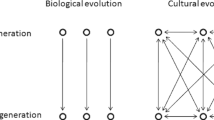Abstract
It is common in attempts to extend the theory of evolution to culture to generalize from the causal basis of biological evolution, so that evolutionary theory becomes the theory of copying processes. Generalizing from the formal dynamics of evolution allows greater leeway in what kinds of things cultural entities can be, if they are to evolve. By understanding the phenomenon of cultural transmission in terms of coordinated phenotypic variability, we can have a theory of cultural evolution which allows us to avoid the various difficulties with the elaboration of informational entities such as the cultural “replicator”, or meme. Such an account is a boon to the project of evolutionary epistemology since it confirms the presumption in favor of the general adaptiveness of culture, illuminating rather than obscuring the inherent intimacy of our relationship to (e.g.) our ideas.
Similar content being viewed by others
References
Boehm, Christopher: 1978, ‘Rational Preselection from Hamadryas to Homo Sapiens: The Place of Decisions in Adaptive Processes’,American Anthropologist 80, 265–296.
Bonner, John T.: 1980,The Evolution of Culture in Animals, Princeton University Press.
Boyd, Robert and Richerson, Peter J.: 1985,Culture and the Evolutionary Process, The University of Chicago Press, Chicago.
Campbell, Donald T.: 1987 [1974], ‘Evolutionary Epistemology’, in Gerard Radnitzky and W. W. III Bartley (eds.),Evolutionry Epistemology, Rationality, and the Sociology of Knowledge, Open Court, La Salle, IL, pp. 47–89.
Cavalli-Svorza, L. L. and Feldman, M. W.: 1981,Cultural Transmission and Evolution: A Quantitative Approach, Princeton University Press.
Dawkins, Richard: 1976,The Selfish Gene, OxfordUniversity Press, New York.
Dawkins, Richard: 1982,The Extended Phenotype, W. H. Freeman and Company, Oxford.
Dawkins, Richard: 1989 [1976],The Selfish Gene, New Edition, Oxford University Press, Oxford.
Dawkins, Richard: 1993, ‘Viruses of the Mind’, in Bo Dahlbom (ed.),Dennett and His Critics, Blackwell, Oxford.
Dennett, Daniel C.: 1990, ‘Memes and the Exploitation of the Imagination’,Journal of Aesthetics and Art Criticism 48, 127–135.
Dennett, Daniel C. 1991,Conciousness Explained, Little, Brown, and Co., Boston.
Dretske, Fred I.: 1981,Knowledge and the Flow of Information, MIT Press, Cambridge, MA.
Hahlweg, Kai and Hooker, C. A.: 1989, ‘Evolutionary Epistemology and the Philosophy of Science’, in Halweg Hooker (eds.),Issues in Evolutionary Epistemology, State University of New York Press, Albany, pp. 21–150.
Hofbauer, Josef and Sigmund, Karl: 1988,The Theory of Evolution and Dynamical Systems, Cambridge University Press.
Hull, David L.: 1988,Science as a Process, University of Chicago Press.
Millikan, Ruth G.: 1984,Language, Thought, and OtherBiological Categories: New Foundations for Realism, A Bradford Book, MIT Press, Cambridge, MA.
Putnam, Hilary: 1983, ‘Why Reason Can't Be Naturalized’, inRealism and Reason, Philosophical Papers. Cambridge University Press pp. 229–247.
Schuster, Peter and Sigmund, Karl: 1983, ‘Replicator Dynamics’,Journal of Theoretical Biology 100, 533–538.
Shannon, Claude and Weaver, Warren: 1949,The Mathematical Theory of Communication, University of Illinois Press.
Skyrms, Brian: 1992, ‘Chaos and the Explanttory Significance of Equilibrium: Strange Attractors in Evolutionary Game Dynamics’,PSA 1992. Philosophy of Science Association, pp. 374–394.
Sober, Elliot: 1991, ‘Models of Cultural Evolution’, inTrees of Life: Essays in the Philosophy of Biology, Australasian Studies in the History and Philosophy of Science,Kluwer, pp. 17–38.
Sober, Elliot and Wilson, D.S.: 1994, ‘Reintroducing Group Selection to the Human Behavioral Scinces’,Behavioral and Brain Sciences 17, 585–654.
Tooby, John and Cosmides, Leda: 1992, ‘The Psychological Foundations of Culture’, inThe Adapted Mind: Evolutionary Psychology and the Generation of Culture, Oxford University Press, pp. 19–136.
Williams, George C.: 1966,Adaptation and Natural Selection, Princeton University Press, Princeton.
Williams, Mary B.: 1970, ‘Deducing the Consequences ofEvolution’,Journal of Theoretical Biology 29, 343–385.
Author information
Authors and Affiliations
Rights and permissions
About this article
Cite this article
Harms, W. Cultural evolution and the variable phenotype. Biol Philos 11, 357–375 (1996). https://doi.org/10.1007/BF00128787
Issue Date:
DOI: https://doi.org/10.1007/BF00128787




